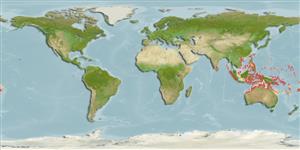Common names from other countries
>
Ovalentaria/misc (Various families in series Ovalentaria) >
Pseudochromidae (Dottybacks) > Pseudochrominae
Etymology: Pseudochromis: Greek, pseudes = false + Greek, chromis = a fish, perhaps a perch (Ref. 45335).
More on author: Schultz.
Environment: milieu / climate zone / depth range / distribution range
البيئة
بحري مرتبطة بالشعاب; نطاق العمق 0 - 30 m (Ref. 37816). Tropical; 26°N - 23°S
Western Pacific: Philippines and Taiwan to Vanuatu, south to northwestern Australia and New Caledonia; eastern Caroline and Marshall Islands in Micronesia.
الحجم / وزن / العمر
Maturity: Lm ? range ? - ? cm
Max length : 8.0 cm TL ذكر/ مختلط الجنس; (Ref. 9710)
الأشواك الظهرية (المجموع) : 3; الأشعة الظهرية الناعمة (المجموع) : 24 - 27; شوكة شرجية: 3; أشعه شرجية لينه: 11 - 14. Yellow tail and yellow spots on body scales that form dotted lines (Ref. 48635).
Inhabits lagoon and seaward reefs (Ref. 1602). Solitary or in pairs under ledges or in caves (Ref 90102).
Life cycle and mating behavior
Maturities | التكاثر | Spawnings | Egg(s) | Fecundities | Larvae
Myers, R.F., 1991. Micronesian reef fishes. Second Ed. Coral Graphics, Barrigada, Guam. 298 p. (Ref. 1602)
IUCN Red List Status (Ref. 130435)
CITES (Ref. 128078)
Not Evaluated
استخدامات بشرية
أدوات
تقارير خاصة
Download XML
مصادر علي الأنترنت
Estimates based on models
Preferred temperature (Ref.
115969): 26.3 - 29.3, mean 28.6 (based on 1905 cells).
Phylogenetic diversity index (Ref.
82804): PD
50 = 0.5000 [Uniqueness, from 0.5 = low to 2.0 = high].
Bayesian length-weight: a=0.00490 (0.00187 - 0.01281), b=3.11 (2.88 - 3.34), in cm Total Length, based on LWR estimates for this (Sub)family-body shape (Ref.
93245).
مستوى غذائي (Ref.
69278): 3.5 ±0.5 se; based on size and trophs of closest relatives
Fishing Vulnerability (Ref.
59153): Low vulnerability (10 of 100).
